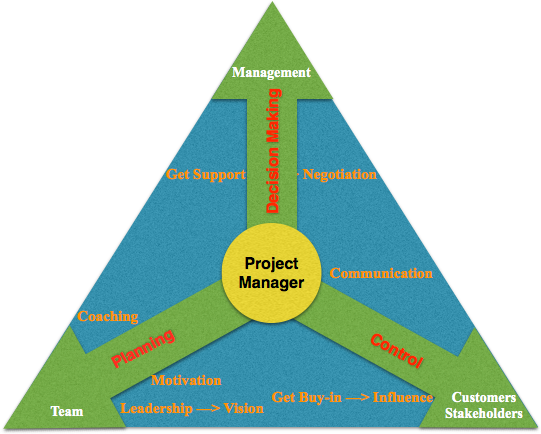

A simple stakeholder-based competency framework- A cocktail of competencies that leads to success
While doing some research for a workshop I organized for Project Managers, I asked myself , like many other fellow project managers I assume, which, among all competencies that a project manager should master (there are many), are the ones that really make the difference? In these days of ever-increasing productivity needs, training should be extremely focused to ensure high return on investment. It seems therefore important to focus on a few key competencies rather than an all-encompassing set of competencies that are needed in different situations.
I first reviewed several interesting papers, among which:
- The article in 2 parts from the late Rita Mulcahy, “Traits of a successful PM”
- The article by Jeff Hogdkinson, Gary Hamilton and Gareth Byatt, “Most important traits to achieve success”.
I tried to determine whether we could link these competencies to critical success factors in project management, by using the Project Implementation Profile by Jeffrey Pinto and Dennis Slevin.
I realized it is not easy to narrow them down and proposed myself to try to develop a model to structure the approach a bit. In this article I would like to share my conclusions.
One approach could be to consider the following question: “To whom do which competencies make a difference?”
Stakeholders have indeed different needs that must be fulfilled for the project to be considered a success.
In order to keep the model simple, let us group the stakeholders in 3 broad categories, each with their own needs:
- Management: they are the people the project manager reports to, usually the Steering Committee including the sponsor and representatives of the impacted lines of business. They expect the project manager to get their support when needed to make the right decisions (such as setting objectives and defining scope at the beginning of the project, solving issues during the project, accepting/rejecting scope changes, approving deliverables, providing additional resources, etc.) and move things forward; in order to achieve that, the project manager must actively control his/her project to focus management on exceptions (deviations from the agreed upon plan) rather than on details.
- Team members: they are the people who do the work in the project and report to the project manager. The team needs the project manager to show leadership by sharing a compelling vision, by motivating them based on their individual profiles, and to coach them on the job to make them more productive in the short term, and successful in their own careers in the long term. The team also needs the project manager to define with them a clear sequence of tasks each team member needs to go through to achieve the project objectives.
- Customers and other stakeholders: they are all the people who will be impacted by the project once the project is delivered. They expect to be informed just about what is necessary and at the right time, and the project manager definitely needs their buy-in to make sure the project brings sustainable results to the organization (whether the customer is internal or external).
In total, 9 competencies emerge from the stakeholder needs. They can be classified in one of 2 broad categories: hard (technical) and soft (people) skills. Let’s review them one by one and give a few words of explanation.
- Leadership -> Vision
A project manager, often called project leader, must show… leadership! This seems pretty obvious. Here by leadership, I intend to focus on the common vision the project manager can build with the team, so that the team considers the project as her own priority. This requires the capability to simplify the picture so that people do not get bogged down into details that often seem complex and hard to solve.
- Motivation
In addition to a clear vision and rationale for the project in the eyes of the team, other, more personal factors play a role in motivating the team to do a stellar job on the project. This is the famous: “what’s in it for me”? The project manager should find individual ways to motivate the team members. Everybody likes a pizza and some fun time, but most people also need to see their contribution in this project as a step in their career, whether by giving them opportunities of promotion, or by providing them the opportunity to develop additional skills, for example.
- Coaching
In order to reach effectiveness and efficiency, the project manager will most likely need to coach team members, whether on soft or hard skills. Some may need to be helped on personal competencies such as time management, or others on improving soft skills like making presentations to the team or writing a good document. It is also sometimes possible for the project manager to help the team member on the content of the project itself, but this should normally be covered by the line manager supervising the team member
- Planning
This is of course one of the core competencies of the project manager and a significant part of the job. Building a Work Breakdown Structure, estimating time and effort required for each activity, building a realistic schedule and budget, planning quality management on the project, developing a risk management plan, communication plan, procurement plan, etc. are key to execute the project smoothly. And it should be done with the help of the team.
- Control
While the team executes the project, the project manager should also closely follow-up the progress and detect any deviations to the plan that might occur in order to minimize their impacts. Detailed KPIs should be built, measured and reported to management to enable proactive decision making.
- Decision Making
The project manager should facilitate issue resolution by preparing options for solutions and presenting them to management with pros and cons, to speed up decisions and minimize impact on the project.
- Getting Support -> Negotiation
The project manager must be able to negotiate with management. Not only should management make decisions, but should show a strong support to the project by reinforcing the project decisions and priorities in their line of business. The project manager should therefore also seek how the project aligns with the individual interests of management to convince them to support the project.
- Communication
Communication should be planned (what, to whom, how, how often) and delivered to the stakeholders. It is by far the most time-intensive activity for the project manager (up to 80%).
If people do not get enough information on the project, they will not be aware of what the project will bring them and likely not support it. The project manager should be proficient in verbal and written communication.
- Getting Buy-In -> Influence
It is of upmost importance to be able to build relations and be able to influence the customer and other stakeholders. Obviously the customer should be kept happy and accept the solution provided by the project. Having the customer interest in mind at all times is probably the most critical success factor. And this is not limited to the customer representative, but also other stakeholders in the customer organization.
The tentative conclusion of this approach is that by looking at the generic needs of stakeholders we can isolate the right mix of skills that addresses most needs and focus on these to reach quick results instead of trying to acquire a very broad set of skills. That does not mean that you do not have to hone a broader skill set in the long term but I believe it is useful to be able to focus on the quick wins.
The main idea was to link three aspects: critical success factors in project management- competencies of the project manager- and… stakeholders !
I am very interested in your comments on this approach.
The picture below summarizes the nine major competencies that seem the most important to master to best interact with all stakeholders.

Now let us assume you would like to develop some of the skills mentioned above. The next question is: where can you find good resources to develop them?
While it is relatively easy to acquire hard skills like planning and controlling from class-based or even web-based trainings, when it comes to soft skills, a less straight-forward learning path seems to be required. One must reflect deeply on one’s own nature first, then understand how others may think and feel, before any major progress can be made. Good books or training can provide knowledge of models to ease understanding, but will not provide enough playground to significantly develop these skills. They must be acquired progressively through experience.
Nevertheless, as a starting point, I would recommend reading the following:
- Planning & Control are fundamental skills of project management and as such are well covered by the PMBOK and the Earned Value books published by PMI. Beyond the basics, I also found the book “Total Project control” by S.A. Devaux interesting, though not easy to implement with available tools (e.g. MS Project) and a bit complex. After a useful reminder on why we need to plan and a visual seven-step process (AIM-FIRE) to manage changes to this planning, this book presents new concepts about how to compare the three sides of the project triangle (scope, time, cost) by using a common unit (dollars). Scope should be translated into customer value which will decrease over time as the market opportunity vanishes. The author makes the observation that the critical path is never determined for sure because of the incertitude on the estimates and provides help to evaluate the activities on and off the calculated critical path that might influence the most the duration of the project over its course. From these metrics and the impact on the Economic Monetary Value of the project, proper decisions can be made to allocate more resources or fast-track some tasks.
- Leadership/Motivation: The book by S.W.Flannes & G.Levin, “People Skills for Project Managers” presents various models giving different and complementary perspectives (Maslow's, age dependent, generation driven, professional development related).It also presents the classic Myers-Brigg's personality types and links these personality types to motivation factors which makes this knowledge practical.I also appreciated the career tips through the book, e.g. the 2-minute introduction. This book is easy to read and provides a lot of tips from real-life experience.
- ·Communication/ Negotiation: In this field, there is the classic book by Fischer & Patton, “Getting to Yes”, and the book “Crucial conversations” by K.Patterson. J Grenny, R. McMillan, A. Switzler can be a life-saver (for moments when stakes are high, how to run a difficult conversation, for example giving difficult feedback).
- ·Communication/ Influence: Made to Stick, by Chip and Dan Heath gets to the point with its powerful “SUCCESs” acronym, standing for Simple, Unexpected, Concrete, Credible, Emotional, Stories.
I hope this is useful and would be delighted if you could share your own references in each of the skill areas above.
Articles on the same topic:
SWAT Teams and the compensation of the entrepreneurial knowledge worker
Blending Learning activities to reach maximum impact
Customer reference: GSK